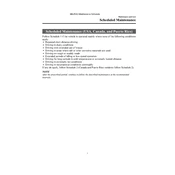Mazda Speed 3 2011 Maintenance Schedule Manual


To reset the tire pressure monitoring system, ensure all tires are inflated to the recommended pressure. Turn the ignition to the "ON" position without starting the engine. Press and hold the TPMS reset button, usually located under the steering wheel, until the TPMS indicator blinks twice.
The recommended oil for the 2011 Mazda Speed 3 is 5W-30 synthetic oil. Always check your owner's manual for any specific requirements or updates.
To replace the cabin air filter, locate the filter housing behind the glove box. Open the glove box and remove the dampener arm. Squeeze the sides of the glove box to lower it fully. Remove the filter cover and replace the old filter with a new one, ensuring it is oriented correctly.
Rough idling in a 2011 Mazda Speed 3 could be due to a dirty mass air flow sensor, faulty spark plugs, or a clogged fuel injector. Inspect these components and clean or replace them as needed.
The 2011 Mazda Speed 3 is equipped with a timing chain that is designed to last the life of the engine under normal operating conditions. However, regular maintenance and inspections are recommended to ensure its optimal function.
The correct tire pressure for the 2011 Mazda Speed 3 is typically 32 psi for the front and rear tires. Always refer to the tire placard located on the driver's side door jamb for the most accurate information.
To troubleshoot the check engine light, use an OBD-II scanner to retrieve any error codes from the vehicle's computer. These codes will help identify the underlying issue. Common causes include a loose gas cap, faulty oxygen sensor, or malfunctioning catalytic converter.
The recommended spark plugs for the 2011 Mazda Speed 3 are iridium-tipped plugs, which provide better performance and longevity. Consult the owner's manual or a certified Mazda dealer for specific brands and part numbers.
To improve fuel efficiency, maintain proper tire pressure, perform regular engine tune-ups, replace air filters as needed, and avoid excessive idling. Additionally, using high-quality fuel and driving sensibly can contribute to better fuel economy.
If the clutch feels spongy, check the clutch fluid level and inspect for leaks in the clutch hydraulic system. Bleeding the clutch system may also help remove air bubbles. If the issue persists, consult a professional mechanic.